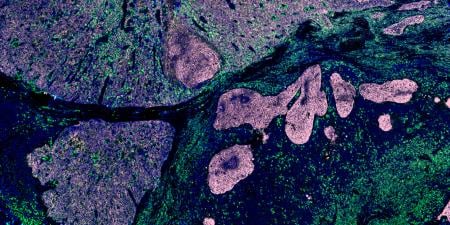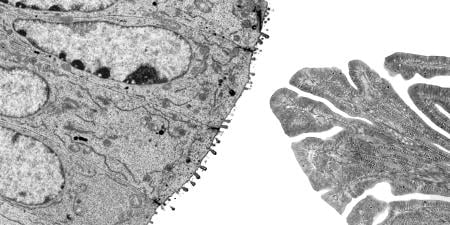Although great strides have been made in the screening, prevention and treatment of cancer, the benefits are only available to those who have ready access to health care. According to recent Surveillance, Epidemiology and End Results (SEER) data, one-third of patients with breast and colon cancer are cured following screening, early detection and adjuvant therapy [1,2]. Disparities in cancer care are still well recognized between those with ready access to care and low-income individuals who present with advanced disease at the time of diagnosis and do not share in the advantages of recent medical achievements. Survival rates among low-income individuals with cancer and other life-threatening illnesses offer revealing insight into the role that insurance plays in patient outcomes.
Medicaid
Almost all of the people with either no health coverage or inadequate health coverage are poor [3]. Over half have incomes that fall below 200 percent of government-designated poverty level, and one-quarter of these have incomes that are actually below poverty level. The uninsured, many of whom are still healthy, are less likely to be working full time and are unable to afford insurance. But the uninsured is a constantly changing group. By definition, its numbers represent individuals who lacked insurance for 12 consecutive months [3]. This figure may miss close to 50 percent of individuals who have coverage for as little as one month each year. Many Medicaid recipients go on and off of this insurance and may be classified as underinsured [4].
Medicaid covers close to 13 percent of the U.S. population but less than 50 percent of those who have no alternative access to insurance. To qualify for Medicaid, patients must meet a combination of income level and population group criteria. Eligible population groups are children, the parents of dependent children, pregnant women, the disabled and the elderly. Childless adults who are not disabled and seniors with low incomes rarely qualify. Eligibility differs by state and, under certain circumstances, is directly proportional to how many dependent children are living at home [3].
The uninsured
Minorities are overly represented among the uninsured; African Americans constitute close to 20 percent; Hispanics, 30 percent. Many of the uninsured have jobs that are seasonal or unsteady—in agriculture or construction—or simply do not offer health care coverage. Jobs that do offer insurance may require a buy-in premium that is too high for their income [3].
The underinsured
Even workers with more secure jobs, like municipal employees in New York City or the self-employed with low incomes, do not have adequate health insurance. Medicaid recipients may fall into this category too. The underinsured are frequently shut out of preventive care and recommended screening and may fail to seek out health services before they develop advanced or incurable disease [5-7]. In a recent study Bradley and colleagues used the Michigan tumor registry to show that subjects enrolled in Medicaid at least one month before being diagnosed with breast, colorectal or lung cancer had double the survival rates of those enrolling in Medicaid in the same month as diagnosis or afterward [6]. Their hypothesis was that subjects who enrolled in Medicaid after diagnosis were more likely to have advanced stage disease and may only have been eligible to enroll because of their diagnosis [6].
Recent research
In another recent study, ambulatory follow-up appointments after emergency room (ER) care were shown to depend heavily on the type of insurance coverage the patient had. Sixty-three percent of callers with insurance coverage received clinic appointments within one week of their ER visit compared with 34.2 percent of those with Medicaid. Among those with no insurance who offered to pay $20 at the time of the visit and the balance later, 25.1 percent were scheduled within one week of the ER visit. Note that even among the insured, one-third of patients were not granted timely outpatient appointments [7].
Over the past decade, studies have begun to call attention to the needs of the uninsured and underserved. As noted earlier some uninsured patients become enrolled in Medicaid only as the result of a hospitalization or a late-stage diagnosis. A 2003 study found that among the patients in Kentucky's Cancer Registry (KCR) database, 31 percent of Medicaid and uninsured patients first presented with stage IV cancer, compared to 17 percent of those with private insurance and 22 percent of those with Medicare [5]. A look at the impact on survival of privately insured compared to uninsured prostate cancer patients showed that 98 percent and 83 percent respectively survived for 3 years; for breast cancer it was 91 percent, and 78 percent; for colorectal cancer, 71 percent and 53 percent; and for lung cancer, 23 percent and 13 percent. Another report showed that the adjusted risk of death four to seven years after diagnosis among breast cancer patients was 49 percent higher for the uninsured and 40 percent higher for Medicaid patients than for privately insured patients [8].
In a study using the Behavioral Risk Factor Surveillance System, more than 100,000 adults were compared for rates of preventive service use, including screening for cancer, cardiovascular disease and diabetes [9]. Nearly half of uninsured adults with annual incomes below $15,000 had not seen a physician when needed during the prior year due to the cost of care. Hypertensive screening was three to four times less likely to occur among the uninsured. Similar findings were present for recommended cancer screening such as mammography. Even breast biopsies appeared to be performed less frequently among those on Medicaid and the uninsured [10]. These patterns lead to advanced stage diagnoses, more intensive treatments and reduced chances for cure. Ultimately, higher health care costs accrue.
The future of health care
The U.S. stands alone among developed countries in not providing insurance to all its citizens [11]. Lack of insurance and limitations on its use have resulted in use of hospital emergency rooms for primary care and increased medical costs. The plight of the uninsured and underinsured affects those with adequate insurance, who now face higher deductibles that limit access to preventive services and ongoing essential care. The per capita cost of health care in this country is the highest among any in the industrialized world, yet the outcomes overall are no better [12].
Major improvements are also needed to enhance quality of care; technological advancements such as informatics add to productivity and encourage physicians to follow evidence-based guidelines. Primary care doctors in the U.S. and Canada lag far behind those in Australia, the Netherlands, New Zealand and the United Kingdom in the use of electronic medical records, clinical test reporting and medication accounting systems [11]. System-wide information technology is capable of tracking patients and preventing treatment errors. With the savings from these initiatives, we should be able to move more aggressively in the direction of universal health care.
References
- Berry DA, Cronin KA, Plevritis SK, et al. Effect of screening and adjuvant therapy on mortality from breast cancer. N Engl J Med. 2005;353(17):1784-1792.
-
National Cancer Institute. SEER: Surveillance Epidemiology and End Results. Available at: http://seer.cancer.gov. Accessed November 29, 2006.
-
US Department of Health and Human Services, Office of the Assistant Secretary for Planning and Education. Overview of the Uninsured in the United States: An Analysis of the 2005 Current Population Survey. Accessed October 28, 2006.
- Grann VR, Jacobson JS. Health insurance and cancer survival. Arch Intern Med. 2003;163(18):2123-2124.
- McDavid K, Tucker TC, Sloggett A, Coleman MP. Cancer survival in Kentucky and health insurance coverage. Arch Intern Med. 2003;163(18):2135-2144.
- Bradley CJ, Gardiner J, Given CW, Roberts C. Cancer, Medicaid enrollment, and survival disparities. Cancer. 2005;103(8):1712-1718.
- Asplin BR, Rhodes KV, Levy H, et al. Insurance status and access to urgent ambulatory care follow-up appointments. JAMA. 2005;294(10):1248-1254.
- Ayanian JZ, Weissman JS, Schneider EC, Ginsburg JA, Zaslavsky AM. Unmet health needs of uninsured adults in the United States. JAMA. 2000;284(16):2061-2069.
- Ayanian JZ, Kohler BA, Abe T, Epstein AM. The relation between health insurance coverage and clinical outcomes among women with breast cancer. N Engl J Med. 1993;329(5):326-331.
- Grann VR, Jacobson JS, Troxel AB, et al. Barriers to minority participation in breast carcinoma prevention trials. Cancer. 2005;104(2):374-379.
-
Schoen C, Osborn R, Huynh PT, Doty M, Peugh J, Zapert K. On the front lines of care: primary care doctors' office systems, experiences and views in seven countries. Health Aff. 2006;25:w555-571. Web exclusive. Available at: content.healthaffairs.org/cgi/content/full/25/6/w555. Accessed December 12, 2006.
-
Hussey PS, Anderson GF, Osborn R, et al. How does the quality of health care compare in five countries? Health Aff. 2004;23:89-99. Available at: http://content.healthaffairs.org/cgi/content/full/23/3/89?maxtoshow=&HITS=10&hits=10&RESULTFORMAT=&author1=Hussey&andorexactfulltext=and&searchid=1&FIRSTINDEX=0&resourcetype=HWCIT. Accessed December 12, 2006.



